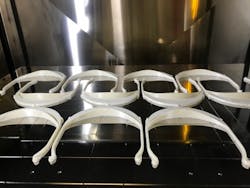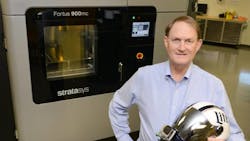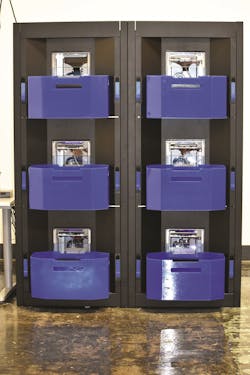Automating Additive Manufacturing
As more companies add 3D printing/additive manufacturing technologies as part of their production operations, it’s not unusual for volume bottlenecks to grow. And like any piece of equipment, there are the inevitabilities of equipment downtime and failed print jobs. All of which can lead to production deadlines being missed.
Crump adds that “additive manufacturing is likely never going to produce the volume scale of traditional manufacturing techniques like injection molding or CNC machining. However, the COVID-19 pandemic has shown Stratasys that the additive production process can benefit from more automation.”
Key to understanding how this works is to recognize the typical constituent components of additive manufacturing:
- Print properties selection;
- Print preparation and orientation;
- Managing in-print queue;
- Initiating printing;
- Removing parts from the 3D printer;
- Post-processing; and
- Finished part retrieval.
Stratasys learned about the value additional automation can bring to 3D printing through the launch of its “COVID Coalition” earlier this year. Comprised of more than 100 organizations (including colleges and manufacturing companies) to achieve the 3D print production of thousands of face shields each week, the complexities of this dispersed production project was streamlined with the use of Stratasys’s GrabCAD Shop workflow software.
Crump says that, a year ago, without this software, “we couldn’t have done it. The complexity of the task would have overwhelmed our ability to manage the initiative.”
Using GrabCAD Shop in combination with GrabCAD Printg to manage printing on each machine enabled Stratasys to “set up each organization as a 3D print shop, with an ability to assign jobs to each location,” says Crump. “And each location has the ability to assign jobs to specific 3D printers. We’ve been able to connect orders from our CRM (customer relationship management) system with cloud-distributed production capacity to know who is doing how much, where, and when things should be done.”
Based on what Stratasys learned about automating the additive manufacturing production process in the “COVID Coalition” project, the company is now taking automation of 3D printing to the next step to further scale 3D printing at higher volumes. Using Stratasys Labs Skylab server software, accessible via a web interface, Crump says that “virtually everything gets automated and centralized from a control center, allowing an operator to monitor incoming part requests, the master queue, available printer resources, printer status, and even business analytics.”
Crump noted a key factor Stratasys discovered during these efforts to add more automation to the 3D printing is to use file analysis to auto-select default print properties. “By assessing orientation, fill styles, color and material availability, and resolution requested, the system can automatically set up the job, along with a start time, build time, and material volume,” Crump says.
Crump says that automating production across these machines has enabled Stratasys to produce 20,000 face shields per month.
This production rate reflects a significant increase in utilization rates. A typical additive manufacturing service bureau, with one FTE for about every ten 3D printers, usually has an FDM utilization rate close to 70%. But the Stratasys Labs operation has been running its 60 printers at 95% utilization, with just one full-time employee.
“By using cloud-based software to automate additive manufacturing work, combined with low cost 3D printers optimized for this software, we can ultimately achieve extraordinarily high utilization rates 24/7 with limited staffing required resulting in a low cost per part and without tooling,” says Crump. “We recently 3D printed 500 visors for face shields overnight with the lights out and no staff. This can open up new application opportunities for 3D printing in the future.”
About the Author
David Greenfield, editor in chief
Editor in Chief

Leaders relevant to this article:


